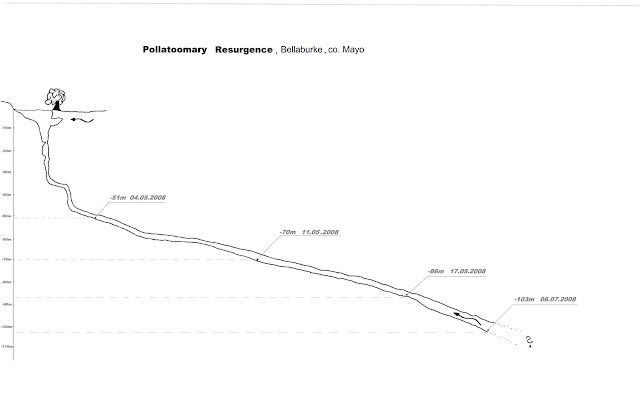In County Mayo in the west of Ireland, the Aille River descends from the Partry Mountains as a small, insignificant stream before sinking underground after a few kilometres at the spectacular Aille Cliffs. It resurfaces 3km away in the village of Bellaburke in a small pond of dark, tannin-stained water. Locally the resurgence is known as Pollflanagan, but the name of its flood overflow, Pollatoomary, was used in the first diving reports and has prevailed among cave divers.
In 1969 the resurgence was plumbed to -20.6m by members of the Craven Potholing Club and then dived by D. Chandler to -15m before he got entangled in the plumb line. In August 1978 Martyn Farr, Dave Morris and Peter Rust found a spacious vertical shaft dropping down to a boulder choke at -28m. Farr wriggled down to -32m, but he terminated the dive when he became uncertain about the stability of the choke. A few days later in a daring assault he broke through the choke into an open passage, 1.5m high and heading north; shortage of air forced him to retreat after another 4m of horizontal progress. It was the last known exploration until 2008.
My first successful attempt to dive the resurgence was on May Bank Holiday. In poor visibility, barely over 0.5m and reduced even further when I disturbed the silt on numerous ledges, I moved mostly by touch past some obstacles at depths of -15m and -23m. When I arrived at -28m, I found that the shaft was obstructed by a boulder choke with flow coming out of a small opening between the wall and the boulders. I pushed in my feet first, trying to feel any space down below with my fins. After 2m of wriggling the passage finally let go and I landed on a clean and washed bottom. Thirty years after the last visit I had regained limits of the exploration. With hands trembling in excitement I secured the line to block of lead on the bottom and advanced carefully. Suddenly, after only couple of meters, the passage started descending once again. Reaching -51m, which also marked the deepest sump in Ireland, I dropped the reel and started a slow ascent back to the surface. During eventful dives over the next few weeks I progressed to -70m and then -86m depth. Here the passage was still sloping down gently at an angle of twenty degrees, and it became obvious to me that the 90m deep terminal sump in Wookie Hole in England’s Mendip Hill was the deepest sump in Britain and Ireland no more. But proving it was something else and the Irish weather did not help at all…
After three weeks of rain in Ireland there was no sign of improvement, but with my trusted cave diving buddy Tom Malone I travelled to Bellaburke on 5 July 2008. The flow was substantial but not prohibitive and the visibility was 0.5m. The first dive to stage decompression cylinders at -6m and -21m showed that there was some hope for a Sunday dive despite the flow pushing us out of the shaft for the first 10m. We decided to stage one of the bottom gas tanks on -60m and wait through the night for the weather and conditions to improve. By noon on Sunday it seemed to be marginally better and I decided to dive.
The line from -70m on was buried under 5-10cm of sand deposited during the three weeks of rain. When I got to my limit on -86m I continued along a sandy, sloping bottom in north-west direction. Passing -90m was just a formality. From there the passage seemed to open up to at least 3m square. I passed the magical -100m and tied off the line at a depth of -103m, from where the cave still continued down at a slightly steeper angle of thirty degrees. At that point I was only 34 minutes into the dive but the dive time ran to 3 hours before I could safely reach the surface.
For decades the underground course of Aille River was strongly believed to be within -30m of depth but even now, with the proven depth of over -100m the drainage pattern seems to be more complicated than that. During my last dive in Pollatoomary, executed after prolonged period of rain in June 2008, a strong upwelling current was encountered in the first couple of metres of the shaft. However, below -10m the flow reduced considerably despite a substantial decrease in the shaft dimension, suggesting perhaps the existence of a shallow, epikarstic drainage. At the same time the deep route seems to be still quite active, especially during flood periods as indicated by the sand deposition over the diving line between May and July 2008. One thing is for sure, with at least 3km of passage at a depth of -100m or more the Pollatoomary - Aille River Cave traverse presents one of the most challenging cave diving projects in the world. Small passages with tight and dangerous restrictions combined with low visibility and great depth will be a seriously limiting factor to those who would try to venture further and deeper into the resurgence. Team diving using multiple underwater scooters, backmounted rebreathers and dozens of stage cylinders - a system which has proved to be so successful in the exploration of big flooded cave systems in Florida and the spacious sumps of continental Europe - seems to have little if any application here. Further exploration of Pollatoomary has been temporarily postponed due to lack of funding - safe deep diving relies on large quantities of expensive helium gas.
The article was published in Irish Speleology no18, 2009




